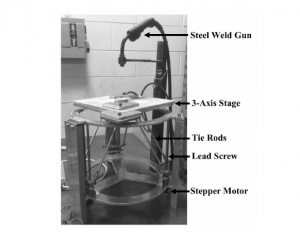A group of researchers from the Michigan Tech Open Sustainability Technology (MOST) Lab claim that they have found a solution to one of the key problems in metal-based 3D printing.

(Image credit: “In Situ Formation of Substrate Release Mechanisms for Gas Metal Arc Weld Metal 3-D Printing”, uploaded to Academia.edu by Dr. Joshua Pearce)
Metal-based 3D printing is a very complex process that comes with a certain number of problems, especially when it comes to post processing. One of the more serious issues is the need to cut the metal part off the metal substrate that it was printed on.
In their recent paper, “In Situ Formation of Substrate Release Mechanisms for Gas Metal Arc Weld Metal 3D Printing”, the researchers – Amberlee S. Haselhuhn, Bas Wijnen, Gerald C. Anzalone, Paul G. Sanders and Joshua M. Pearce – state that they have solved this problem with the use of substrate release mechanisms for gas metal arc weld metal 3D printing.
“(Our) study provides an in-depth investigation into low-cost and no-cost substrate release mechanisms that allow gas metal arc weld 3D printed ER4043 aluminium and ER70S-6 steel parts to be removed from a reusable print substrate with minimal energy,” the scientists state in their research paper.
“Aluminium oxide, boron nitride, and titanium nitride coatings were evaluated as possible substrate release agents for aluminium printing. Additionally, the in situ formation of substrate release agents such as intermetallics and oxides were tested for both aluminium and steel printing.”
Using a stationary Millermatic 140 with an M-100 weld gun, thy printed the steel parts; whereas aluminium parts were printed with a stationary Miller Spoolmate 100 weld gun.
The researchers managed to successfully knock their finished 3D printed metal parts off of the support substrate with a mild knock of a hammer. Once the 3D printed part was successfully removed, the researchers were able to recycle the substrate into another round of printing.
“Low-cost methods, such as the use of aluminium oxide, boron nitride, and titanium nitride coatings, were also found to be effective substrate release agents for aluminium 3-D printing as long as a chemical binder was present in the coating solution. In addition to reducing the overall costs of producing 3-D metal parts, these substrate release mechanisms also minimised the waste and concomitant environmental impact associated with 3-D metal printing by yielding substrates suitable for reuse,” the researchers state.




















